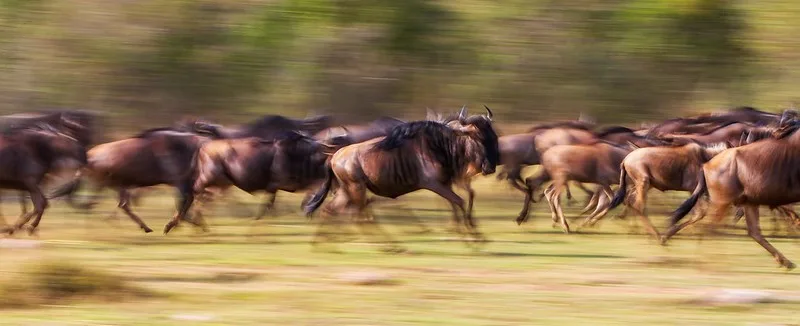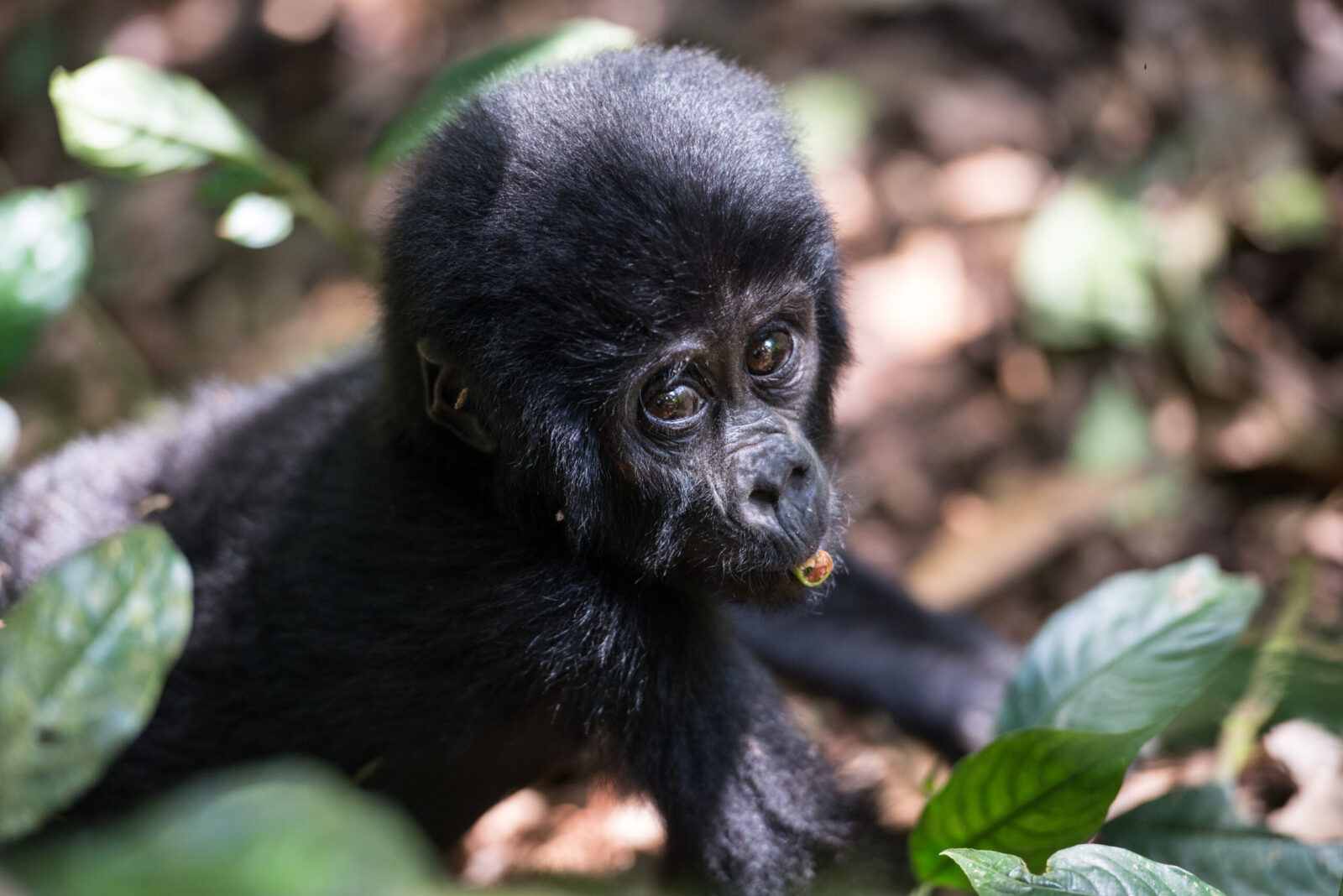Best Time To Witness Masai Mara wildebeest Migration.
Masai Mara wildebeest Migration
The Masai Mara National Reserve’s mass migration is predicted to gather up steam between July and September. However, due to erratic rainfall patterns in various years, this period may change over time. Sometimes the big migration begins earlier than anticipated and ends earlier because to early rains, and vice versa.
Masai Mara National Reserve is a year-round attraction because of its moderate temperature and diverse wildlife, but the best time to go on a Mara safari is during the Great Migration of the Wildebeest. The Masai term “Mara” means “spotted” locally, although it’s still unclear why it was given this name.
Compared to other African game parks, the reserve’s landscape is largely flat, making it much easier to see animals, particularly birds. Because of the massive migration of wildebeests, Thomson’s gazelles, Grant’s gazelles, impalas, and zebras, the Masai Mara National Reserve is one of the top safari locations in Africa.
Masai Mara National Park has gained international renown for its abundant animals and significant migration. Because no one can influence the migration of herds of wild animals over a certain amount of time, it is one of the wonders of the world.
Predators like lions, hyenas, cheetahs, jackals, and eager vultures ready to clean up are all involved in this big angulate migration. Each of them may choose from a variety of prey in the crowd. It is among Kenya’s most popular national wildlife parks.
Established in November 1974, the Masai Mara Reserve now covers an area of around 1510 square kilometers. Its highest point is 5000 feet. The drive from Nairobi, Kenya’s capital, is around 275 kilometers.
Expectations in the Masai Mara National Reserve All Year Long
Normal January temperatures in the Masai Mara National Reserve are a little warmer, yet there may be an average amount of rainfall. There is some activity in the park, even if there may not be as many animals as at the busiest times of the year.
Additionally, infantry begins during this period when new babies are born. With so many birds hanging around the park, this is the moment for ornithologists to shine in the Masai Mara. You could get the opportunity to see migrating birds that are common in regions of North Africa and Europe if you’re an avid birder. The Masai Mara National Reserve is home to more than 470 bird species, including around 57 raptors, and the number is constantly expanding.
Due to the abundance of food for grazers and the thicker grass, which provides a hiding spot for newborns from predators, February is often a month with a large number of babies. Due to fewer safari vehicles and more pristine terrain, this is one of the greatest seasons to visit the Masai Mara National Reserve if you’re a wildlife photographer.
Expect to observe more babies when visiting the Masai Mara National Reserve in March, particularly among the ungulates. March is one of the most well-known rainy seasons in the Masai Mara, provided that the weather stays consistent.
The park’s trails could be a bit more slippery due to the rivers’ overflowing and the constant rains. As the number of visitors to the reserve declines, most lodges close to renovate.
Since April is often a slow month, wildlife drives in the Masai Mara National Reserve may not be possible due to poor road conditions. A large number of animals hide from the severely cold and rainy weather, yet some may be seen.
Depending on the current weather conditions for the year, May might occasionally be either wet or fairly dry. The temperature may occasionally climb a bit more than in prior months, or it may even shower all day. This might result in rather slick roads with a sticky muck that could make automobile tires’ weak treads not work as they should. Because of global climate change, this is not a definitive weather condition.
In Kenya, the dry season typically begins in June, if all other conditions remain the same. In Kenya, the busiest safari season has just begun. The animals may still be covered by the grass that grew during the previous wet season. As the dry season approaches, temperatures in the Masai Mara National Reserve begin to increase. Preparations for the peak season are well underway, despite the fact that the reserve is receiving fewer tourists at this time.
The early migrant wildebeests from the Serengeti may reach the Masai Mara in July in order to graze on the grass that has been left over from the previous rainy seasons. The big five—elephants, lions, rhinos, leopards, and buffaloes—should be easier to spot this time around. Due to the dry weather, most wild animals stay near their water sources. As the peak season intensifies, the increased number of tourists is causing a crowd, particularly in safari cars.
It should be easier to see the Masai Mara National Reserve’s massive migration in August. The animals could cross the Mara River more than once a day due to the very dry weather, all other things being equal. The park’s somewhat warmer-than-normal temperatures have dried off part of the grass and increased the visibility of wild animals.
September often brings high temperatures and the possibility of wild animals remaining on the Masai Mara side. This month is still a time to watch the enormous migration. Due to the exceptionally dry weather in the reserve, there is a lot of predator activity as the grass dries out.
October is often dry, and many roving wild animals begin to make their way back to their homes. The majority of the zebras, gazelles, and wildebeests continue to browse along the Mara River before returning to Tanzania’s Serengeti National Park. Masai Mara National Reserve may see a minor decrease in temperature towards the end of October when the rainy season starts in November.
In Serengeti National Park, the final group of ungulates may come home in November. Showers may occur during the day, resulting in exceptionally chilly weather conditions in the evening, when the rains begin to fall a little. After the incredibly dry season of the preceding months, the grass begins to recover.
The Masai Mara National Reserve is less crowded in December, which allows for last-minute lodge upgrades since more visitors are anticipated over the holiday season.
Take note
The aforementioned monthly study of Masai Mara National Reserve activities may vary based on the year’s weather. Since the Great Migration is an impromptu occurrence, it may occasionally alter. Many of the wonderful grazing options and movement activities offered to the wild animals are influenced by the patterns of rainfall.
Understanding Masai Culture | Masai Mara wildebeest Migration
Using an informed Masai guide will allow you to fully appreciate the trip, which includes cultural fusion. The native inhabitants of this region are the Masai, who have maintained their culture for ages.
They are pastoralists who depend on livestock for their livelihood. They may utilize the Masai Mara’s boundaries when cattle are grazing. The quantity of cattle that one owns is a measure of their prosperity.
The Masai, who reside in Manyattas, together defend their livestock from lions, leopards, hyenas, cheetahs, jackals, and other predators, as well as wrestlers. Over time, they have adapted to living with the wild creatures, despite losing some of their livestock to raptors.
Along with other conservation organizations, the Kenyan government raises awareness among the Masai people about the importance of wild animals. With the assistance of conservation groups, some former poachers are assisting their community in spreading the conservation message, even though it is not yet entirely successful.
Wearing beaded necklaces with red robes and a rapper skirt is fashionable in Masai culture. The majority of them have dot tattoos on their faces, and some ladies have braided hair and long holes in their earlobes that are adorned with big earrings. Their distinctive bouncing dancing motions might keep your camera going all day. Their mud-huts, which resemble beehives and are polished with cow dung, have an incredible architectural design.
Masa Mara National Reserve Travel Instructions | Masai Mara wildebeest Migration
By vehicle,
It might take around 275 kilometers to drive from Nairobi to the Masai Mara National Reserve. Although you may hire a driver, it offers you greater confidence to have an experienced Kenyan guide. Nobody wants to go on safari with someone who doesn’t know anything about the place, since it makes the experience dull.
By air.
To spare you the hassle of spending a lot of time traveling, Kenya offers a variety of domestic airline carriers. Traveling to the Masai Mara National Reserve might be difficult at times due to the slick roads in the countryside caused by overflowing rivers. On the road, renting an aircraft may often save you a lot of money. You can reserve a seat on the daily domestic scheduled flights or charter as well.
How Much Does a Safari To The Masai Mara National Reserve Cost?
The trip package you select will determine how much your safari to the Masai Mara National Reserve costs. As long as you pay the park entrance fee, which is a cost that affects everyone’s budget, other expenses vary depending on what you want to do in the park, where you stay during the safari, how many people you are traveling with, how many days you spend in the reserve, and a host of other factors.
Packages for the Masai Mara range from luxury upmarket packages to midrange safari packages to low-cost safari packages.
The cost of your Masai Mara National Reserve safari package may also depend on when you go. Lodge rates are somewhat higher during the peak seasons, which are June through September and December through January. This is due to the large number of visitors from all over the world who are eager to spend time in the African wilderness, particularly to see the Great Migration.
If seeing the Great Migration is on your bucket list, you should reserve your lodging early because lodges fill up quickly around the busiest time of year. Some lodges may put you on a waitlist if you reserve too late, which might damage your safari experience and cause uncertainty.
Items You Should Bring on a Safari in the Masai Mara National Reserve: Safari bungalow. It’s a wise choice to wear a hat in the outdoors to shield your hair from buzzing insects. You must wear safari clothing to protect your head because the paths are also dusty.
Bringing convertible safari clothing in eco-friendly hues enhances the experience. On chilly early-morning game drives, you can wear trousers; when it gets too hot, you can switch to shorts. Bring safari clothing that you can wear comfortably on dusty roads, such as khaki and tan.
Repellant for insects
to smear stinging insects over the body and repel them.
A fantastic lens for a camera, especially for photographers and people who want to take amazing pictures of their safari trip.
A first aid pack for unexpected situations when on safari.
Just in case you need it, some hard currency to utilize for transactions or personal expenditures.
A pair of binoculars to see creatures that are far away more clearly.
If you ever get the chance to go outside, you should wear safari boots to protect your feet from creepers or exotic insects. Without an armed ranger guide, this is not advised.
Toiletries, in case you have delicate skin or your lodge does not supply these.
If you need some aeration, especially after a hard day in the field, you can change into flip flops.
Wearing sunscreen will protect your skin if you have to stand in the pool in the sun.
To shield your eyes from the scorching heat, use sunglasses.
At the resorts that offer pool service, guests can wear swimming costumes.
Just in case there are bugs at your resort, use insect repellent.
A flashlight for useift solar power runs short.


